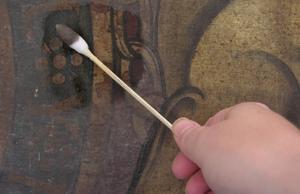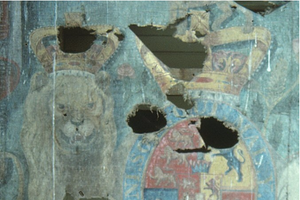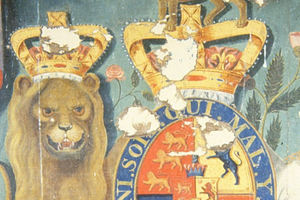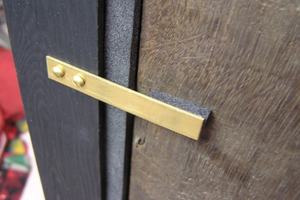Judgement, Resolution, and Treatment
Active Treatment and Passive Prevention

Active Treatment and Passive Prevention
The questions surrounding the treatment of Royal Arms are also applied to other paintings found in churches.
The frequency of alterations and a tendency towards wholesale repainting in later centuries, raise specific questions as to which version should be exposed.
Removing a later version, no matter how crude, destroys a historical paint layer and exposes a potentially damaged image beneath. Unless the upper layers can be shown to be damaging the underlying original paint, uncovering is not usually attempted on ethical, as well as technical grounds.

The critical question for a conservator dealing with Royal Arms after conservation in churches is ‘should long-term stability be prioritised over originality and authenticity?’ The dilemmas faced include:
- Framing unframed paintings to allow it to be hung safely
- Providing a stretcher to create correct tension, even if it was not the original method
- Whether or not to re-touch missing paint and if so, should it be invisible or made obvious?
- Varnishing an unvarnished painting to offer protection against an active bat colony
 Conservation treatment can be divided into three main areas:
Conservation treatment can be divided into three main areas:
- Structural: necessary to stabilise the structure of the painting
- Cosmetic: to improve the appearance of the painting
- Preventive: to prevent further damage from occurring
Cosmetic treatment is surface cleaning, varnish removal, filling and retouching losses to the paint layer and revarnishing the surface.
 Preventive conservation often has little influence on the painting’s appearance and may involve making improvements to framing and hanging fittings, isolating a painting from the wall behind it, installing temporary covers for bat protection and, if necessary, relocating the painting away from a damp wall, bat roost, heater or unsuitable light fitting.
Preventive conservation often has little influence on the painting’s appearance and may involve making improvements to framing and hanging fittings, isolating a painting from the wall behind it, installing temporary covers for bat protection and, if necessary, relocating the painting away from a damp wall, bat roost, heater or unsuitable light fitting.Although the actual treatment is minimal and unobtrusive, preventive conservation will often be the most effective way of promoting the long-term stability of Royal Arms.

